Share this article
Restoring arid western habitats — from The Wildlife Professional
Native Plants Maximize Wildlife Conservation Effectiveness
Greater sage-grouse (Centrocercus urophasianus) and monarch butterflies (Danaus plexippus) and other pollinating insects have garnered a lot of attention recently from federal and state wildlife officials. These two species and pollinators share dwindling sagebrush habitat in the western United States that is putting their populations at risk. Sagebrush landscapes transformed by disturbances often require significant effort to restore their ecological function, and achieving desired results can be far more difficult and slow without the correct strategy. Fortunately, habitat restoration efforts focused on increasing the abundance and diversity of critical forbs can simultaneously benefit all three at-risk populations.
Research and development projects such as The Great Basin Native Plant Project — a joint effort of the Department of the Interior, Bureau of Land Management and the U.S. Forest Service — are at the forefront of propagating plant materials and monitoring effectiveness of restoration of sagebrush (Artemisia spp.) plant communities (Dumroese et al. 2015). However, a major hurdle confronting successful forb restoration in the sagebrush ecosystem is commercial propagation of sufficient quantities of plants and their seeds in order to make large-scale projects economically feasible. Notable challenges include seed dormancy that prevents prompt and complete germination during field establishment, indeterminate seed ripening times, short plant stature that makes mechanical harvesting difficult and lengthy times between initial seed sowing and first-seed harvest.
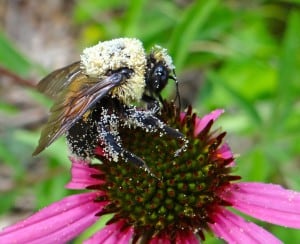
The important role of pollinators, such as this bumble bee (Bombus spp.), to the economic and ecosystem health of the United States and conservation of their populations, is the focus of recent federal attention. ©R. Kasten Dumroese
The Bureau of Land Management’s recently released National Seed Strategy specifically discusses the need for more research on species-specific methods for improved production of seeds and plants of native species for restoration work (Plant Conservation Alliance 2015). While successfully growing all the forbs needed for restoration of the sagebrush ecosystem has a ways to go, the number of plants doing well in commercial settings is increasing. Plus, the anticipated demand from land managers responding to a DOI Secretarial Order to restore sagebrush habitats should provide added incentive for growers to improve the supply and diversity of forbs offered for restoration work.
In order to maximize the effectiveness of wildlife recovery efforts, western land managers in arid regions will require a broad palette of forbs. But before these efforts can proceed further, some questions need to be answered, including, which forbs will provide the most benefit and have the widest applicability to sage-dependent species? And which methods for deploying the plants are most successful?
Three in Need
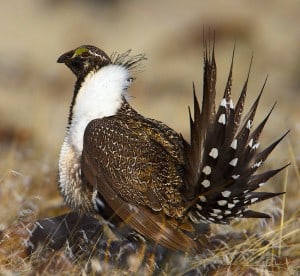
Greater sage-grouse may serve as an umbrella species for a variety of wildlife species in the sagebrush ecosystem. This means restoration of the birds’ habitat will likely benefit many other species at the same time. ©Stephen Ting, U.S. F&WS
From 2014–2015, policy makers stepped up national efforts to address challenges facing sage-grouse and pollinator species including monarchs.
President Obama’s Executive Memorandum issued in June 2014 directed federal agencies to develop strategies, define research priorities, build conservation frameworks and implement best management practices to promote the health of honey bees, monarchs and other pollinators.
Declining greater sage-grouse populations also got a lot of attention when the U.S. Fish and Wildlife Service determined that the species did not warrant listing as a federally endangered species under the Endangered Species Act. This decision was based on a tremendous five-year research and conservation effort by numerous state and federal agencies, research institutions and stakeholders across 11 western states to better understand threats affecting the birds and their habitat.
Although approximately 350 animal species — many with their own unique habitat requirements — occupy sagebrush ecosystems, some conservationists have suggested that sage-grouse are an “umbrella species” because their decline is an indicator of overall sagebrush ecosystem health. Declining health of the sagebrush landscape affects a number of other species of concern such as the pygmy rabbit (Brachylagus idahoensis), sagebrush vole (Lemmiscus curtatus), pronghorn (Antilocapra americana), sage sparrow (Artemisiospiza belli), Brewer’s sparrow (Spizella breweri) and sage thrasher (Oreoscoptes montanus).
Recognizing that western sagebrush ecosystems remain threatened, in January 2015, DOI Secre
Secretary Jewell ordered development of management strategies (Secretarial Order 3336), clearly linking conservation of sage-grouse to protecting and restoring the sagebrush landscape. This linkage provides support for a holistic conservation plan — with multiple management objectives — that has the potential to benefit other flora and fauna such as monarchs, pollinating insects and others. It also provides improved leverage of available resources and more benefit to the landscape.
Forbs Are Foundational
More than 5,000 native plant species grow within the bounds of the sagebrush ecosystem, including nearly 30 taxa of sagebrush and a significant number of monotypic and species-rich genera. These forbs support a diverse abundance of invertebrates including herbivores, detritivores, predators and pollinators. In fact, in one Idaho sagebrush site, nearly 2,100 insect species have been identified.
Interactions between forbs and pollinating insects occur at many levels. At the species level, some forbs support an immense variety of insect pollinators. At the broader scale, abundance and diversity of insect pollinators are positively correlated with overall herbaceous plant species diversity. This is most likely because temporal differences in blooming reduce inter-species competition for food sources, which is an important consideration when restoring habitat for insect pollinators including monarchs.
Unlike bees that require nectar and pollen as a food source throughout their life cycle, adult monarchs are floral generalists that visit flowers only to obtain nectar, which is their primary energy source. The butterflies also convert sugar in the nectar to body fat that sustains them during migration and through the winter when most flowering plants are dormant. This means that nectar sources are particularly important during late summer and fall as monarchs begin their long migration to overwintering sites either in the mountains of Mexico or along the California Coast.
Forbs are also crucial, directly and indirectly, to greater sage-grouse. Annual and perennial forbs are an especially critical dietary component for nesting and brooding hens and chicks. Research shows that young chicks consume more than 66 forb taxa. Insects that feed on the forbs, along with other invertebrates, also serve as a high-protein food source for the birds. At least 41 insect families are known to be consumed by chicks, and their survival increases with greater forb and invertebrate consumption (Dumroese, et al. 2015).
Connecting Forb and Wildlife Restoration
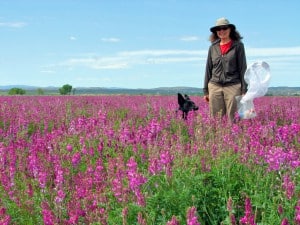
©James H. Cane
Given this knowledge, various sage-grouse assessment frameworks, pollinator plant lists and milkweed reports have encouraged land management practices that incorporate a broad suite of genetically appropriate native forbs. Even so, typical seed mixtures for sage-grouse habitat restoration work often have limited numbers of forb species, ranging from just two to six plants.
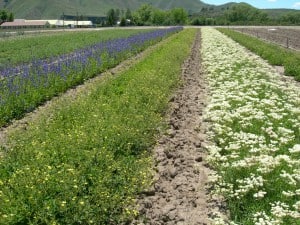
Although many species of forbs, such as Utah sweetvetch are already in production, reliable methods are needed to economically produce a broader suite of sage brush species with appropriate genetics to meet restoration objectives. ©Matt Fisk, USFS
To support the use of a broader suite of forbs in the sagebrush ecosystem, which in turn will aid restoration of more wildlife species, USFS researchers reviewed a list of sagebrush plant species and segregated them into three categories: most likely preferred by sage-grouse (Stiver et al. 2015), consumed by sage-grouse, and recommended for pollinating insects (Dumroese et al. 2015).
Of the resulting 225 taxa, 40 genera were associated with two or more categories. Twelve genera were common to all three categories: milkvetch (Astragalus), balsamroot (Balsamorhiza), mariposa lily (Calochortus), hawksbeard (Crepis), fleabane (Erigeron), buckwheat (Eriogonum), avens (Geum), desert parsley (Lomatium), bluebells (Mertensia), aster (Symphyotrichum), clover (Trifolium), and vetch (Vicia). Asters, which typically bloom in late summer and fall, are also important for migrating monarchs.
However, some genera include annual forbs that pose economic challenges in large-scale production.
One in particular, slender phlox (Microsteris gracilis var. gracilis), may be worth the effort because it improves brood survival of sage-grouse chicks (Gregg and Crawford 2009).
In addition, some evidence from restoration sites suggests that annual forbs may compete well with invasive species; and therefore, it may be worthwhile to use them as initial occupants on degraded sites until later seral forbs become established.
Forb Deployment Strategies
Western land managers also face other enormous challenges. Not only do numerous large tracts of land need to be restored, but the ongoing, unnatural effects of large, repetitive wildfires exacerbated by invasive annual grasses make restoration efforts difficult. Most efforts rely on direct seeding and seed mixtures that are usually formulated using available seeds. While this approach is thought to be the most economically plausible option, success can be limited and recovery speed can be slow (Shaw et al. 2005). Increasingly, planting nursery-grown seedlings into their final field location — known as outplanting — is gaining favor due to its good success rate.
On a large scale, outplanting is considered expensive. Nevertheless, seedlings may have an important role in corridor or island planting strategies, especially in reconnecting quality habitats. Habitat connectivity is important for sage-grouse, supports abundant and diverse bee communities, and is crucial for effective pollination of specific genera of forbs, some of which are consumed by sage-grouse. In the end, the outplanting strategy may be a way to mitigate restoration costs while simultaneously enhancing restoration success.
The idea of outplanting seedlings to establish vegetation islands that serve as seed sources and nucleate restoration areas is not new. In some instances, researchers have shown that it is better than passive restoration efforts. While outplanted vegetation islands have yet to be thoroughly tested in sagebrush rangelands, remnant native plant islands in naturally disturbed sagebrush ecosystems have shown their ecological value. Such islands create and maintain microsites that influence surrounding atmospheric and soil properties, making them more favorable for forb seedling recruitment than interspatial zones. Strategically, the goal in restoration outplanting is to mimic remnant islands and their benefits.
Recent work also shows that nursery-produced seedlings paired with proper site preparation can significantly increase outplanting survival and growth. This strategy may be a way to increase the restoration trajectory of degraded sites. By combining workhorse shrub species along with forb species that offer maximal benefit to a wide variety of wildlife, these island plantings may have the potential to provide improved habitat sooner and serve as year-round food sources and sources for future seed dispersal.
Linking Efforts for Wider Applicability
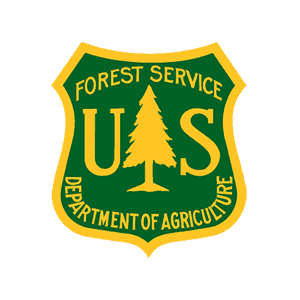 We are still learning how to best plan restoration efforts that include a robust complement of forbs that maximize benefits for multiple sagebrush-obligate species. By linking forb and wildlife restoration, land managers can maximize ecosystem benefits and more effectively leverage funding resources. For example, proposals for funding could explicitly identify how a particular project, or set of projects, meets multiple species conservation objectives. Subsequently, planning and project implementation could leverage holistic restoration methods (Pyke et al. 2015) to show more broad-scale ecosystem benefit.
We are still learning how to best plan restoration efforts that include a robust complement of forbs that maximize benefits for multiple sagebrush-obligate species. By linking forb and wildlife restoration, land managers can maximize ecosystem benefits and more effectively leverage funding resources. For example, proposals for funding could explicitly identify how a particular project, or set of projects, meets multiple species conservation objectives. Subsequently, planning and project implementation could leverage holistic restoration methods (Pyke et al. 2015) to show more broad-scale ecosystem benefit.
 |
Kas Dumroese, PhD, is a research plant physiologist in the USFS Rocky Mountain Research Station, Grassland, Shrubland and Desert Ecosystems Science Program in Moscow, Idaho, and the national nursery specialist with the USFS National Center for Reforestation, Nurseries and Genetic Resources. |
 |
Jeremy Pinto, PhD, is a research plant physiologist in the USFS Rocky Mountain Research Station, Grassland, Shrubland and Desert Ecosystems Science Program in Moscow, Idaho, and the tribal nursery specialist with the USFS National Center for Reforestation, Nurseries and Genetic Resources. |
 |
Deborah Finch, PhD, is a supervisory biologist and program manager for the USFS Rocky Mountain Research Station, Grassland, Shrubland and Desert Ecosystems Science Program in Albuquerque, N.M. |
Header Image: A male monarch butterfly feeds on common milkweed (Asclepias syriaca L.). Members of the Asclepias family are the sole food source for monarch caterpillars, and their flowers provide exceptional nectar resources for a wide variety of pollinators. ©Dave Wendelken








